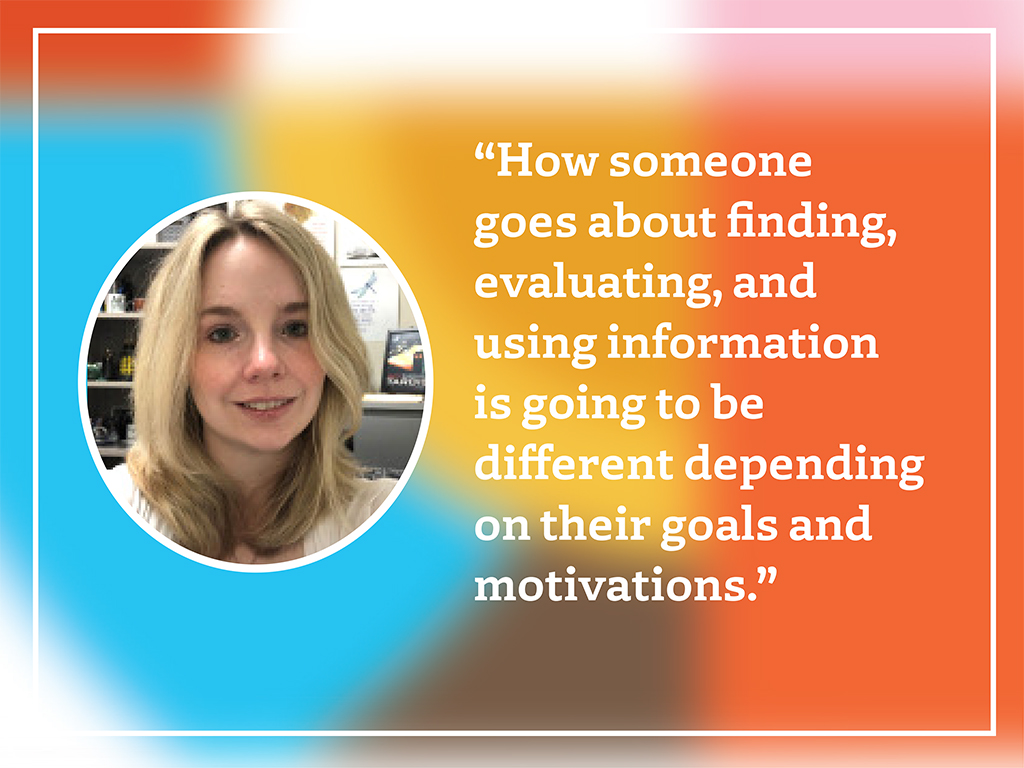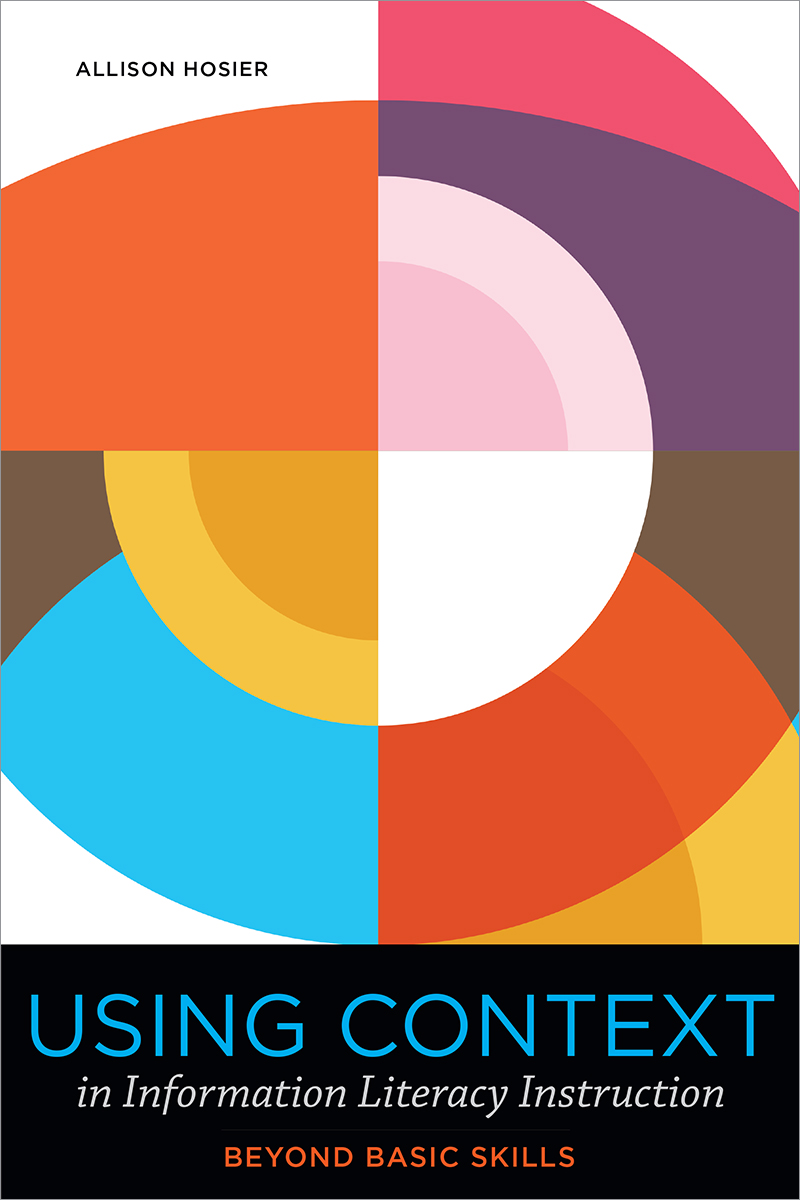Moving beyond the basics: an interview with Allison Hosier about information literacy instruction
Using context when teaching information literacy is an approach that can lead to a substantive and enduring impact on students' lifelong learning. In her new book, instructor and information literacy scholar Alison Hosier takes readers through each step of the research process, sharing ideas for adding context no matter the mode of teaching. Here she discusses what it was like as a first-time author to write the book during the pandemic, offers some practical pointers for instructors, and explains why she doesn't necessarily focus on the "trustworthiness" of sources.
Congrats on the book! Though you’ve written numerous articles and book chapters, this is your first full-length work. What was the genesis of the project and your biggest surprise while you were writing it?
Thanks so much! I’d been thinking about writing a book for a while, but it always seemed like sort of a “someday” goal. I just didn’t feel brave enough or confident enough to take on such a big project. But then Patrick Hogan, an acquisitions editor for ALA Editions at the time, contacted me about an article I’d written for College & Research Libraries News on using improv in the classroom. He liked the article and wanted to see if I might have any pitches for a book project. I had a few ideas in mind but I settled on this one because I thought it would give me an opportunity to really dive into some of the ideas I’d been exploring in my other writing about the contextual nature of research and how it’s represented in the ACRL Framework for Information Literacy. In those past works, I’d suggested ways to restructure information literacy courses to teach research through this lens, similar to how writing is taught in composition courses with a  focus on genre and form. But in presenting this model to various audiences, I realized how unrealistic it was to suggest such a complete overhaul of the traditional approach to teaching IL. Most librarians just aren’t in a position to make such big changes to their teaching. So I decided that the focus of the book would be on incorporating these ideas into existing models of instruction—not just credit-bearing courses but also one-shot sessions, tutorials, reference interactions, and so on. I wanted librarians to see that there are ways of teaching students about the importance of context to the research process without having to throw out their current learning goals, lesson plans, and assessments. As for surprises, there were a lot of them! I started working on this project in April 2020, just after the start of the pandemic. It was a stressful time and being a first-time book author made it seem even more stressful, at first. But I found that by carving out some time to write every day and creating doable goals for myself, I was able to create a routine that gave me something to focus on other than how worried I was about everything that was happening. Working on this book really helped me get through that difficult time.
focus on genre and form. But in presenting this model to various audiences, I realized how unrealistic it was to suggest such a complete overhaul of the traditional approach to teaching IL. Most librarians just aren’t in a position to make such big changes to their teaching. So I decided that the focus of the book would be on incorporating these ideas into existing models of instruction—not just credit-bearing courses but also one-shot sessions, tutorials, reference interactions, and so on. I wanted librarians to see that there are ways of teaching students about the importance of context to the research process without having to throw out their current learning goals, lesson plans, and assessments. As for surprises, there were a lot of them! I started working on this project in April 2020, just after the start of the pandemic. It was a stressful time and being a first-time book author made it seem even more stressful, at first. But I found that by carving out some time to write every day and creating doable goals for myself, I was able to create a routine that gave me something to focus on other than how worried I was about everything that was happening. Working on this book really helped me get through that difficult time.
Your book’s core concept is that research is a contextual activity. In your view, why is this such a crucial starting point for information literacy instruction?
Traditionally, information literacy instruction focuses on the skills and concepts associated with academic and scholarly research. In the past, with the ACRL Information Literacy Competency Standards, we generally trusted that teaching students these skills and concepts would prepare them for research in their personal and professional lives as well. However, the research that tried to prove the transferability of what we were teaching tended to be mixed. It wasn’t clear that what we were doing was working the way we wanted it to. When the ACRL Framework for Information Literacy came out, it didn’t try to portray research as a set of basic, one-size fits all skills. Instead, it acknowledged the importance of context to the research process. The reason context is important is because how someone goes about finding, evaluating, and using information is going to be different depending on their goals and motivations. Teaching students about the contextual nature of research helps them understand the value of the research experience they might already have, no matter what it might be, while also making it clear that even for the most expert researchers, there's always more to learn, with every new context. I also feel that teaching students to effectively navigate different research contexts—not just those that require academic and scholarly skills—is important if we want our teaching to have long-term impact because it helps students realize that their research experience did not begin and will not end with their academic careers. It is something they will continue to do in one form or another throughout their lives.
You place a big emphasis on taking a very flexible approach to teaching information literacy so that it can be done effectively regardless of whichever mode an instructor happens to be using. Can you offer some pointers for employing this strategy?
I'm very fortunate that most of my teaching currently takes place in the form of a credit-bearing information literacy course in which I have a lot of flexibility as far as what I teach and how I teach it. My sense is that this is fairly rare in our profession and focusing only on credit-bearing courses with that kind of flexibility would have really limited the potential audience for the book. So I wanted to challenge myself to think about how these ideas can be useful no matter what form of instruction a librarian practices, whether it’s in the classroom, through a tutorial, or at the reference desk. That said, I’m not trying to be prescriptive. The practical suggestions I’ve included in the book are meant to be jumping-off points only, something to be used as inspiration. Readers can adapt these examples however they want to or they can use their own ideas. For those who want to get started but aren’t sure how, I would recommend starting small and thinking about what’s best for their specific situation, goals, interests, and institutional context. Trying something new can be scary, especially if you’re used to a certain way of doing things, but remember that teaching is itself a learning experience. Don’t be afraid to experiment and see what happens. You can always make changes next time if something doesn’t quite work. And if you need someone to be your cheerleader or bounce ideas off of, I’m always available!
Another part of your book addresses ways to cultivate students to become good decision-makers for the best type of research sources. Where does learning how to gauge the trustworthiness  of sources fit in?
of sources fit in?
To be honest, I don't necessarily focus on "trustworthiness" as a quality to pay attention to per se because confirmation bias is such that we will always find information we like or agree with more "trustworthy" than information we don't, even if we have good intentions and try to be objective in our evaluation. Unfortunately, that's just how the human mind works and it can't be fixed with simple checklists of criteria, though tools like that can be useful as a starting point, especially for beginners. So instead I try to teach students about confirmation bias and other fallibilities associated with human reasoning and how they affect the evaluation of information no matter what context you’re working in. Even if confirmation bias isn't a problem that information literacy and librarians can "solve," it's still important for students and other users to know about it because research has shown that it affects everyone, regardless of their education level, political affiliation, or socioeconomic status. So it’s not just your political meme-sharing aunt on Facebook. It’s all of us, including you. I also focus on teaching students how to match a source to an information need, which is something the Framework talks about. This is easier to do when you're also talking to students about the importance of context to the research process. Too often, in our focus on academic and scholarly contexts, we emphasize peer-reviewed and otherwise scholarly sources as a sort of gold standard. Which they are ... when you're working in academic and scholarly contexts. But when you're working in another context—a personal, professional, or creative one—whether or not a source is scholarly matters less. In fact, scholarly sources may even be inappropriate in those situations. So rather than teaching students that there is a type of source that is always the "right" one, I think we need to teach them to pay attention to how they make decisions about what information they use and how context affects those decisions.
Learn more at the ALA Store.
